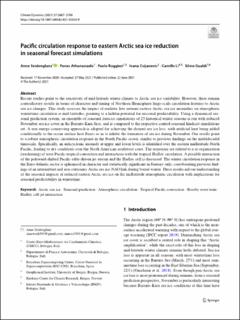| dc.contributor.author | Seidenglanz, Anne | |
| dc.contributor.author | Athanasiadis, Panos J. | |
| dc.contributor.author | Ruggieri, Paolo | |
| dc.contributor.author | Cvijanovic, Ivana | |
| dc.contributor.author | Li, Camille | |
| dc.contributor.author | Gualdi, Silvio | |
| dc.date.accessioned | 2022-03-21T14:30:56Z | |
| dc.date.available | 2022-03-21T14:30:56Z | |
| dc.date.created | 2021-06-24T10:46:24Z | |
| dc.date.issued | 2021 | |
| dc.identifier.issn | 0930-7575 | |
| dc.identifier.uri | https://hdl.handle.net/11250/2986594 | |
| dc.description.abstract | Recent studies point to the sensitivity of mid-latitude winter climate to Arctic sea ice variability. However, there remain contradictory results in terms of character and timing of Northern Hemisphere large-scale circulation features to Arctic sea ice changes. This study assesses the impact of realistic late autumn eastern Arctic sea ice anomalies on atmospheric wintertime circulation at mid-latitudes, pointing to a hidden potential for seasonal predictability. Using a dynamical seasonal prediction system, an ensemble of seasonal forecast simulations of 23 historical winter seasons is run with reduced November sea ice cover in the Barents-Kara Seas, and is compared to the respective control seasonal hindcast simulations set. A non energy-conserving approach is adopted for achieving the desired sea ice loss, with artificial heat being added conditionally to the ocean surface heat fluxes so as to inhibit the formation of sea ice during November. Our results point to a robust atmospheric circulation response in the North Pacific sector, similar to previous findings on the multidecadal timescale. Specifically, an anticyclonic anomaly at upper and lower levels is identified over the eastern midlatitude North Pacific, leading to dry conditions over the North American southwest coast. The responses are related to a re-organization (weakening) of west-Pacific tropical convection and interactions with the tropical Hadley circulation. A possible interaction of the poleward-shifted Pacific eddy-driven jet stream and the Hadley cell is discussed. The winter circulation response in the Euro-Atlantic sector is ephemeral in character and statistically significant in January only, corroborating previous findings of an intermittent and non-stationary Arctic sea ice-NAO link during boreal winter. These results aid our understanding of the seasonal impacts of reduced eastern Arctic sea ice on the midlatitude atmospheric circulation with implications for seasonal predictability in wintertime. | en_US |
| dc.language.iso | eng | en_US |
| dc.publisher | Springer | en_US |
| dc.rights | Navngivelse 4.0 Internasjonal | * |
| dc.rights.uri | http://creativecommons.org/licenses/by/4.0/deed.no | * |
| dc.title | Pacific circulation response to eastern Arctic sea ice reduction in seasonal forecast simulations | en_US |
| dc.type | Journal article | en_US |
| dc.type | Peer reviewed | en_US |
| dc.description.version | publishedVersion | en_US |
| dc.rights.holder | Copyright The Author(s) 2021 | en_US |
| cristin.ispublished | true | |
| cristin.fulltext | original | |
| cristin.qualitycode | 2 | |
| dc.identifier.doi | 10.1007/s00382-021-05830-9 | |
| dc.identifier.cristin | 1918092 | |
| dc.source.journal | Climate Dynamics | en_US |
| dc.source.pagenumber | 2687-2700 | en_US |
| dc.relation.project | Norges forskningsråd: 255027 | en_US |
| dc.identifier.citation | Climate Dynamics. 2021, 57, 2687-2700. | en_US |
| dc.source.volume | 57 | en_US |

